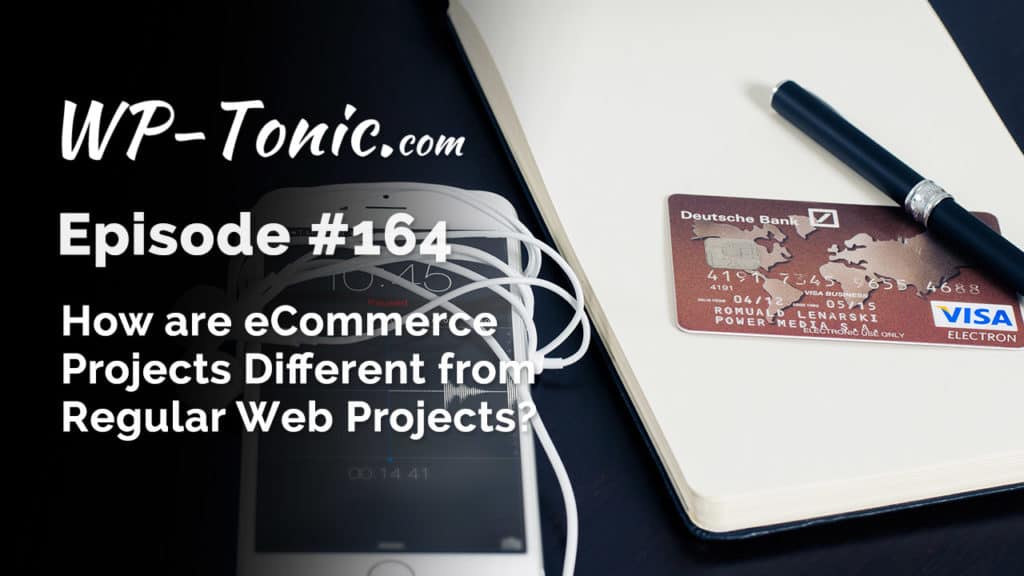We have a great discussion here with Cody Landefeld, co-founder of Mode Effect, a WordPress and eCommerce agency that has worked with Fortune 500 companies.
Our episode this week is sponsored by Liquid Web. Liquid Web is offering a 33% discount for 6 months. Head over to LiquidWeb.com/wordpress and use the code WPTONIC33 at checkout for your discount.
WordPress New Stories
1 – Logging Into WooCommerce.com Now Requires a WordPress.com Account
https://wptavern.com/logging-into-woocommerce-com-now-requires-a-wordpress-com-account
2 – WordPress Telemetry Proposal Addresses Long-Standing Privacy Concerns as GDPR Compliance Deadline Looms
3 – Content Injection Vulnerability in WordPress 4.7 and 4.7.1
https://blog.sucuri.net/2017/02/content-injection-vulnerability-wordpress-rest-api.html
Main Topic: Differences Between eCommerce and Regular Websites
There are many things clients don’t realize about eCommerce projects before preparing for them. Technical factors such as hosting, SSL configuration, site architecture, and photography are just a few.
Shared hosting doesn’t cut it for eCommerce projects. WooCommerce and other eCommerce platforms are full-blown web applications, and require adequate server resources to work properly. Skimping on hosting is a bad idea for an eCommerce site.
Payent gateways and SSL certificates are two more things that are essential for an eCommerce site. Cody and John both recommend all sites have SSL, especially now that Chrome is displaying “Not secure” warnings for non-HTTPS sites. Payment gateways have to be thought out and planned for ahead of time. Allowing for extra time to set up the payment gateways and test transactions is an extra step not present in regular marketing websites.
What About First Time E-Commerce Sites?
For first-time eCommerce stores, Jonathan recommends that you start on Shopify, to gauge interest in your product. If there is consumer interest, then you can move to a custom WooCommerce shop. John is cautious about building custom WooCommerce stores for first-time store owners, as the cost may be high compared to the ROI. He looks at incoming revenue as an indicator of whether WooCommerce is a good solution.
Cody has an even better stance. He interviews the business owner to see what their experience is in running an online business. If the store is brand new, but the business owner has experience with eCommerce, then he does not feel investing in a large scale web project is a risk. If it is both a first time business owner and newly launched store, then he assesses the situation.
Product Stories and Driving Traffic to your Site
Telling your story, and the story of your product is one of the most overlooked aspects of marketing an eCommerce site. How does the product fit into your customer’s life and improve it? What is the reason an eCommerce company creates a product to begin with?
Much as we’d like every site to be a “build it and they will come” scenario, your website isn’t a field of dreams. You must have a strategy for driving traffic and telling your story in a way that makes people believe in your company.
Marketing and driving traffic is perhaps the #1 thing that takes eCommerce site owners by surprise. It is just as important to have a cohesive content strategy for your eCommerce site as it is for your marketing site.
Secondary Marketing Channels for eCommerce
Every eCommerce site can benefit from having products on a secondary platform. Amazon is the platform that Cody says almost every physical product can benefit from being listed on. Your customers are already on Amazon, so it is natural to have your brand there as well.
Google Shopping and other secondary platforms like eBay, Pinterest, or Etsy may also apply, depending on what you are selling, but Amazon is the one secondary platform that all physical eCommerce products can benefit from.
Integrating Bricks and Mortar and eCommerce
Order fulfillment, distribution, and shipping are different when you have a central warehouse compared to a physical store location (or several). Having processes in place for processing and fulfilling orders, and shipping the products needs to be part of the plan with eCommerce.
It is also good to plan your shipping costs, and work with various shipping agents (UPS, USPS, DHL, FedEx, etc.) and have a delivery system in place as part of your infrastructure.
eCommerce and Mobile
Of course, your e-commerce store needs to be mobile-friendly, as mobile use is still increasing. Ordering from your phone or other mobile deice is part of everyday life now, so checking the user flow through your site is a must before launch.
Summary
There are so many moving parts that exist in an online store that aren’t present in a brochure site. Being aware of these ahead of time and having a plan is key to launching and maintaining a successful eCommerce website.
We want to thank Cody Landefeld once more for his expertise and insight in this informative episode.
SUBSCRIBE ON ITUNES




